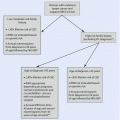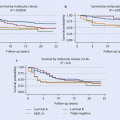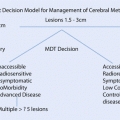Fig. 45.1
The role of breast MRI in this subset of patients is not clear yet, although it may have a role in cases of diagnostic difficulty/discordancy
45.5 Differential Diagnosis
The differential diagnosis of a breast mass in a male includes gynaecomastia, pseudogynaecomastia/lipomastia, infection/breast abscess, lipoma, pseudoangiomatous stromal hyperplasia (PASH), granular cell tumour, desmoid tumour, schwannoma, myofibroblastoma, haemangioma, metastases to the breast and other non-breast cancer primary tumours such as sarcomas [9, 37]. Fibroadenomas of the male breast are very rare due to the absence of breast lobules.
45.6 Genetic Counselling
All men diagnosed with BC should be referred for genetic counselling and, if indicated, BRCA mutation testing. Currently, the National Comprehensive Cancer Network recommends consideration of BRCA1/2 testing in men with a personal history of BC [38]. Also risk counselling should be given to healthy men with Klinefelter’s syndrome. Although routine mammographic screening is not advocated, breast self-examination and regular physical breast examination are recommended in men with Klinefelter’s syndrome [33].
45.7 Staging
After a diagnosis of MBC is established, the extent of disease should be determined with a bone scan and CT scan of the chest, abdomen and pelvis, as clinically appropriate according to the same guidelines as in females. MBC is classified according to the tumour, nodes, metastasis (TNM) staging system [38] which does not differentiate between male and female diseases.
45.8 Histopathology
Although most histologic subtypes of female BC also present in men, there is still a need to better understand the pathology of MBC.
The predominant histological type of MBC is invasive ductal cancer which constitutes more than 90% of cases. Lobular cancer is less common in males than females and accounts for only 1.5% of cases (compared to 10% in females) because the male breast is rudimentary and lacks acini and lobules. Neither differentiation nor lobule formation occurs unless the breast is exposed to increased concentrations of endogenous or exogenous oestrogen. Other rare histological types include papillary and mucinous cancers [39]. Regarding ductal carcinoma in situ (DCIS), there are differences in men when compared to women. DCIS constitutes a larger proportion of female BCs than in MBCs overall (20% vs. 7–11%, respectively). DCIS in men tend to occur in more elderly males, often as an intraductal papillary form with a low grade [40]. More than half of DCIS cases present as intermediate grade. Only 17–33% of cases were found to be high grade [9]. Registry data has shown that MBC patients have significantly more nodal involvement than female BC patients and therefore MBC cases present with more advanced disease [41] (◘ Table 45.1).
Table 45.1
Stage distribution of male and female breast cancer cases
Male breast cancer (%) | Female breast cancer (%) | |
|---|---|---|
Stage I | 10–40 | 30–45 |
Stage II | 15–45 | 40–50 |
Stage III | 20–50 | 5–15 |
Stage IV | 5–15 | 3–5 |
As in postmenopausal women, the most common subtype of MBC is oestrogen receptor-positive (ER+) tumours. SEER database findings revealed that more than 90% of MBC were oestrogen receptor (ER) positive which is more common than it is in female BC where 70% ER+ is the normal proportion. The ER positivity rate increases with age in MBC as it does in females. Also, 92–96% of MBCs are progesterone receptor (PR) positive. [23, 41]. Men also have higher mean expressions of ER, PR and proliferation genes such as Ki-67, MYBL2, Survivin, Cyclin B1 and STK15 [42].
Studies using standardized methodology by both immunohistochemistry and fluorescence in situ hybridization showed lower rates of Her2-neu overexpression in MBC (2–15%) when compared to the rate observed in female BC (18–20%) [9, 43].
Findings from several studies showed that MBCs from patients with BRCA1/BRCA2 mutations display different pathologic characteristics when compared to female BC with BRCA1/BRCA2 mutations. MBC with BRCA1 mutations seemed to have a lower grade when compared to female BC with BRCA1 mutations, but grade distribution was more likely to be similar between female and male BC cases with BRCA2 mutations. Also, MBC patients with either BRCA1 or BRCA2 mutations had more advanced disease at presentation when compared to those with female BC carrying mutations. Also, ER and PR expressions in MBC patients with BRCA1 and BRCA2 mutations were higher than those observed in female BC cases with same gene mutations (◘ Table 45.2) [13, 44].
Table 45.2
Histologic and stage characteristics of male and female breast cancer patients with BRCA1 and BRCA2 mutations
Male breast cancer | Female breast cancer | |||
|---|---|---|---|---|
BRCA1 (%) | BRCA2 (%) | BRCA1 (%) | BRCA2 (%) | |
Stage | ||||
0–I | 14 | 29 | 50 | 48 |
II | 43 | 47 | 43 | 41 |
III–IV | 43 | 24 | 8 | 11 |
Grade | ||||
I | 4 | 3 | 3 | 7 |
II | 27 | 40 | 18 | 42 |
III | 69 | 57 | 79 | 51 |
IHC expression | ||||
ER positivity | 90 | 97 | 24 | 77 |
PR positivity | 79 | 87 | 21 | 65 |
Her2 overexpression | 11 | 17 | 9 | 13 |
In female BC, DNA microarray studies have identified five molecular subtypes which are normal breast-like, Luminal A and B type, Her2 overexpressing and basal-like [45]. Although data on genomic subtyping of MBC is scarce, the frequency of subtypes is different than that of those in female BC cases. In MBC cases, Luminal A subtype (83–98%) is the most common type, followed by Luminal B (0–17%). The Her2-overexpressing subtype and basal-like tumours are infrequent in MBC (0–5%) [46]. Furthermore, the basal-like MBC expresses ER in 75% of cases in contrast to female BC in which only 30% of basal-like cases have ER expression [47].
Considering the possibility that MBC is a different disease than female BC by recognizing the dissimilarity of frequency of standard intrinsic subtypes in MBC and female BC, studies with more comprehensive methods revealed different subtypings of MBC. One of these studies was based on high-resolution genomic profiling. In this methodology, two genomic subgroups with significantly different aberrant copy number levels were identified among MBC: male-complex and male-simple cancers. The male-simple cancer subgroup consists of 20% of MBC cases and appeared to be comprised of less aggressive and small tumours. These cancers were remarkably different from those of previously described six BC subgroups and seemed to represent a new subgroup seen only in males [48, 49]. Male-complex cancers which were found to be more aggressive were overall similar to those in luminal-complex subgroup of female BC [49]. In another study, MBC was grouped using global gene expression profiles, and here again two distinct subgroups were identified: Luminal M1 and Luminal M2. Across the study’s dataset, Luminal M1 cancers consisted of 70% of cases and the rest were Luminal M2 cancers [50]. Luminal M1 cancers had low correlation to genes associated with ER signalling and were found to carry more aggressive phenotype with worse prognosis, whereas Luminal M2 cancers had high expression of genes associated with ER signalling. When comparing these two new subtype groupings of MBC to standard intrinsic groups defined for female BC, MBC cases in each subgroup did not fit completely into previously described intrinsic subtypes [50]. On the other hand, newly described above subtypes overlap partly with each other in which nearly 90% of the Luminal M1 tumours were found to be male-complex, whereas nearly half of the Luminal M2 cancers were male-simple [50, 51].
N-acetyltransferase-1NAT1, a xenobiotic metabolizing enzyme, was identified as a promising prognostic biomarker for MBC. NAT1 positivity was associated with better outcome [50].
Cell cycle regulatory proteins are also aberrantly expressed in MBC. The tumour suppressor gene tp53 is mutated in 3.7–54% of MBC cases. The oncogene c-myc is overexpressed in 12–100% of MBC. The proto-oncogene bcl-2 which inhibits apoptosis and promotes cell growth was found to be significantly higher in MBC than in female BC. Cyclin D1, related to cell cycle regulation, is overexpressed in approximately 50% of MBC. Upregulation of p21waf1 and cdk inhibitor p27Kip1 is more frequent in MBC than that in women with BC [2]. Intratumoural aromatase expression is shown in 27% of MBC patients, and its expression was found to be associated with improved 5-year overall survival [52].
45.9 Treatment
As it is in female BC patients, the treatment strategy for MBC involves surgery, radiation therapy (RT) and systemic treatments.
45.9.1 Breast Surgery
Surgical treatment of MBC is similar to that of female BC and depends on the extent of disease at presentation. Standard treatment for early-stage disease (T1-T2, N0-N1) is surgical resection with free margins. Although there is no reported randomized trial comparing different types of surgical procedures in males, most patients (70%) undergo mastectomy. This may necessitate chest wall muscle removal (8–30%) due to the reduced volume of breast tissue, meaning muscle invasion is more likely. Breast-conserving therapy (BCS; 1–13%) is less commonly offered for the obvious reason that breast mound preservation is less of an issue in males cosmetically but also even in males with early-stage disease. BCS is less likely to be considered due to lack of breast tissue. Only in men who have sufficient breast tissue without overt nipple-areola involvement BCS is an appropriate option to allow achievement of free surgical margins with acceptable local recurrence rates [53]. No satisfactory data exist for the adequacy of immediate or late reconstruction after skin sparing (with or without nipple-areola sparing) mastectomy in MBC patients.
45.9.2 Management of Axilla
A large database study reported that nearly 40% of male patients present with nodal involvement; therefore, axillary dissection is performed more frequently than in female BC patients overall. In patients with clinically node-negative MBC, sentinel lymph node biopsy (SLNB) was proven to be feasible with low morbidity [2]. Although the accuracy of SLNB in males has not yet been confirmed in a large series, the American Society of Clinical Oncology (ASCO) expert panel recommended its use in men with clinically node-negative BC. According to this panel, men with a negative SLN do not require further surgery. The necessity for complete axillary clearance in men with a positive SLN is still a controversial issue, as indeed it is in women. Therefore, the approach to the male patient with a positive SLN should be similar to that in women [54].
45.9.3 Radiation Treatment
The indications for RT for MBC patients are extrapolated from those for women due to the scarcity of data. Radiotherapy is indicated in MBC patients who undergo (i) mastectomy for T3 or T4 cancer, (ii) following BCS, (iii) mastectomy with deep surgical margin involvement and (iv) axillary clearance in which at least one lymph node was found to be metastatic. There are no established data which provide evidence that postmastectomy RT is required for patients with multifocality, high-grade disease, high tumour proliferation markers and peritumoural vascular extension. A cohort study found that the majority of male patients are treated appropriately with adjuvant RT showing that 36% of N1 and 15% of N2 patients did not receive RT [22].
As in women, the benefit from RT must be weighed against the risks of treatment-related toxicities due to the older age of the MBC patients. The standard RT dose is 50 Gy in 2 Gy fractions: an extra boost dose may also be considered in cases of suboptimal surgical margins where further surgery is not possible [55]. However, although data is only valid for female patients, hypofractionation (3 weeks instead of 5) may have a role in these patients as well [56].
45.9.4 Systemic Treatment
Adjuvant Chemotherapy
In MBC patients, there are no well-designed, prospective trials assessing the effects of adjuvant chemotherapy, either in localized or metastatic disease series. Therefore, guidelines written for women with BC apply for males regarding adjuvant systemic therapy. In MBC, due to lack of a high-level evidence, optimal chemotherapy (CT) regimens are not yet defined.
Historically improved 5-year survival rates were shown in the 1990s in MBC patients who received adjuvant cyclophosphamide, methotrexate and 5-fluorouracil (CMF) or 5-fluorouracil, adriamycin and cyclophosphamide (FAC) regimens as compared to those who did not receive CT [57]. More recent data has revealed that CMF after mastectomy provided a 5-year survival rate of over 80% in MBC patients with nodal involvement. In another large cohort study, after receiving adjuvant CT consisting of mainly anthracycline-based regimens, it was found that 5- and 10-year overall survival rates were 86% and 75% and 70% and 43%, in MBC patients with lymph node-negative and lymph node-positive disease, respectively [58]. A recent large registry study also reported that there is an increasing trend for administering anthracycline-based (43%) regimens alone or combination with taxanes (32%) instead of CMF regimens (15%) [22]. Therefore, administering adjuvant CT to high-risk MBC patients is thought to be effective with enhancing outcomes and should ideally follow standard regime recommendations as for female patients [59].
Adjuvant Hormonal Treatment
Increased expression of ER and PgR in MBC indicates the likely efficacy of hormonal treatment in these patients. Although there are no randomized trials focusing on hormonal treatment in MBC, tamoxifen administration for 5 years is accepted as the standard of choice in the adjuvant treatment of HR-positive MBC. Use of tamoxifen decreases recurrence rates and improves overall survival in MBC patients when compared to those who do not receive tamoxifen [58]. However, tamoxifen is not well tolerated in males. The most common side effects include decreased libido, weight gain, hot flashes, mood alteration, depression, insomnia and thrombosis. Side effects caused poor compliance, so about 21% of cases discontinued their treatment [60].
Regarding other hormonal regimens such as luteinizing hormone-releasing hormone (LHRH) agonists or aromatase inhibitors (AI), there is no convincing data to support the use of them in MBC patients at present [61].
As potential hormonal treatment agents for MBC, anti-androgen drugs such as bicalutamide, enzalutamide and abiraterone acetate are being studied currently in phase 2 trials [62]. Since androgen receptor (AR) expression was reported to be positive in 39–95% of MBC [63], favourable findings of anti-androgen treatment in prostate cancer patients create expectations for similar efficacy in MBC patients [64]. However, currently there is no evidence that anti-androgen treatment is effective in MBC patients in any setting or sequence. The results of these studies are awaited with interest.
Targeted Treatment
There is no data regarding the efficacy of adjuvant trastuzumab in MBC. Her2 receptor expression in MBC is less common than in women [46]. Given the proven therapeutic benefit seen with adjuvant trastuzumab in women with Her2-positive BC, it seems reasonable to offer trastuzumab to men with Her2-positive tumours [22].
45.9.5 Treatment of Locally Advanced Disease
In men with T3/T4 or inflammatory breast cancer, the treatment strategy should mirror that of females. Primary systemic CT is recommended as the first-line treatment and surgery to be reserved for those whose tumours later become operable. Postmastectomy RT is generally recommended in such cases and adjuvant tamoxifen is used for ER-positive disease [9]. There is lack of data about using primary systemic hormonal treatment in men with HR-positive locally advanced BC.
45.9.6 Treatment of Distant Metastatic Disease
A large registry study reported that 3.8% of MBC patients are found to be metastatic at initial diagnosis [22]. Distant metastases subsequently develop in between 18 and 54% of male BC patients [65]. Due to the high incidence of ER-positive tumours, hormonal treatment is often the first approach in the metastatic setting. As in the adjuvant setting, tamoxifen is the first choice with a response rate of 80% in this subgroup [58, 59]. On the other hand, further data are warranted to understand the efficacy of AI and LHRH analogues in MBC patients. If AIs are considered, they should be administered together with LHRH agonists. CT for metastatic MBC is used as second- or third-line treatment after failure to tamoxifen or in HR-negative disease. Here, limited evidence suggests that FAC as the CT regimen is more effective than single or other combination drug treatments [66].
45.10 Prognosis
In reports comparing MBC and female BC, matched for age at diagnosis, grade and stage did not show a worse survival in men when compared to that in women [9]. Blacks with MBC have a worse prognosis than whites in the USA based on historic SEER database data (however socioeconomic factors relating to health funding may impact on US data) [67]. Significant prognostic factors of MBC are identical to those in the female, namely, tumour size, nodal status and immunophenotype (ER+). The prognostic value of AR expression is still controversial [22, 63]. Also, whether Her2 overexpression is a marker for poor prognosis in MBC remains uncertain. Until now there is limited data regarding the role of multigene prognostic and predictive profiling tests in MBC. Only study which analysed a small cohort from Israel found that distribution of 21-gene recurrence score in ER-positive MBC patients is similar to that of female BC patients [68]. But profiling tests’ accuracy in MBC cases was not studied yet.
Stay updated, free articles. Join our Telegram channel

Full access? Get Clinical Tree







